4-氯噻吩[2,3-D]嘧啶, 99%,4-Chlorothieno[2,3-d]pyrimidine
产品编号:西域试剂-WR128852| CAS NO:14080-59-2| 分子式:C6H3ClN2S| 分子量:170.62
本网站销售的所有产品仅用于工业应用或者科学研究等非医疗目的,不可用于人类或动物的临床诊断或者治疗,非药用,非食用,
| 英文名称 | 4-Chlorothieno[2,3-d]pyrimidine |
|---|---|
| CAS编号 | 14080-59-2 |
| 产品熔点 | 109-113ºC |
| 产品沸点 | 285.7±20.0 °C at 760 mmHg |
| 产品密度 | 1.5±0.1 g/cm3 |
| 产品闪点 | 126.6±21.8 °C |
| 精确质量 | 169.970551 |
| PSA | 54.02000 |
| LogP | 1.79 |
| 外观性状 | 淡黄色固体 |
| 蒸气压 | 0.0±0.6 mmHg at 25°C |
| 折射率 | 1.710 |
相关文档
化学品安全说明书(MSDS)
下载MSDS质检证书(COA)
相关产品
| 危害码 (欧洲) | Xi |
|---|---|
| 风险声明 (欧洲) | 25-36 |
| 安全声明 (欧洲) | 26-45 |
| 海关编码 | 2934999090 |
Synonym:None Known Section 2 - COMPOSITION, INFORMATION ON INGREDIENTS
Risk Phrases: 36/37/38 Section 3 - HAZARDS IDENTIFICATION EMERGENCY OVERVIEW
Irritating to eyes, respiratory system and skin. Potential Health Effects Eye: Causes eye irritation. May cause chemical conjunctivitis. Skin: Causes skin irritation. May be harmful if absorbed through the skin. Ingestion: May cause gastrointestinal irritation with nausea, vomiting and diarrhea. May be harmful if swallowed. Inhalation: Causes respiratory tract irritation. May be harmful if inhaled. Chronic: No information found. Section 4 - FIRST AID MEASURES Eyes: Immediately flush eyes with plenty of water for at least 15 minutes, occasionally lifting the upper and lower eyelids. Get medical aid. Skin: Get medical aid. Flush skin with plenty of water for at least 15 minutes while removing contaminated clothing and shoes. Wash clothing before reuse. Ingestion: Never give anything by mouth to an unconscious person. Get medical aid. Do NOT induce vomiting. If conscious and alert, rinse mouth and drink 2-4 cupfuls of milk or water. Inhalation: Remove from exposure and move to fresh air immediately. If not breathing, give artificial respiration. If breathing is difficult, give oxygen. Get medical aid. Notes to Physician: Treat symptomatically and supportively. Section 5 - FIRE FIGHTING MEASURES General Information: As in any fire, wear a self-contained breathing apparatus in pressure-demand, MSHA/NIOSH (approved or equivalent), and full protective gear. During a fire, irritating and highly toxic gases may be generated by thermal decomposition or combustion. Extinguishing Media: Use water spray, dry chemical, carbon dioxide, or appropriate foam. Section 6 - ACCIDENTAL RELEASE MEASURES General Information: Use proper personal protective equipment as indicated in Section 8. Spills/Leaks: Clean up spills immediately, observing precautions in the Protective Equipment section. Sweep up or absorb material, then place into a suitable clean, dry, closed container for disposal. Avoid generating dusty conditions. Provide ventilation. Section 7 - HANDLING and STORAGE Handling: Minimize dust generation and accumulation. Avoid contact with eyes, skin, and clothing. Keep container tightly closed. Avoid ingestion and inhalation. Use with adequate ventilation. Wash clothing before reuse. Storage: Store in a tightly closed container. Store in a cool, dry, well-ventilated area away from incompatible substances. Store under an inert atmosphere. Section 8 - EXPOSURE CONTROLS, PERSONAL PROTECTION Engineering Controls: Facilities storing or utilizing this material should be equipped with an eyewash facility and a safety shower. Use adequate ventilation to keep airborne concentrations low. Exposure Limits CAS# 14080-59-2: Personal Protective Equipment Eyes: Wear appropriate protective eyeglasses or chemical safety goggles as described by OSHA's eye and face protection regulations in 29 CFR 1910.133 or European Standard EN166. Skin: Wear appropriate protective gloves to prevent skin exposure. Clothing: Wear appropriate protective clothing to prevent skin exposure. Respirators: A respiratory protection program that meets OSHA's 29 CFR 1910.134 and ANSI Z88.2 requirements or European Standard EN 149 must be followed whenever workplace conditions warrant respirator use. Section 9 - PHYSICAL AND CHEMICAL PROPERTIES Physical State: Solid Color: pale yellow Odor: Not available. pH: Not available. Vapor Pressure: Not available. Viscosity: Not available. Boiling Point: Not available. Freezing/Melting Point: 104.4-106.5 deg C Autoignition Temperature: Not available. Flash Point: Not available. Explosion Limits, lower: Not available. Explosion Limits, upper: Not available. Decomposition Temperature: Solubility in water: Specific Gravity/Density: Molecular Formula: C6H3N2ClS Molecular Weight: 170.623 Section 10 - STABILITY AND REACTIVITY Chemical Stability: Stable at room temperature in closed containers under normal storage and handling conditions. Conditions to Avoid: Dust generation. Incompatibilities with Other Materials: Oxidizing agents, alcohols, amines, bases. Hazardous Decomposition Products: Hydrogen chloride, carbon monoxide, oxides of nitrogen, oxides of sulfur, carbon dioxide. Hazardous Polymerization: Has not been reported Section 11 - TOXICOLOGICAL INFORMATION RTECS#: CAS# 14080-59-2 unlisted. LD50/LC50: Not available. Carcinogenicity: 4-Chlorothieno[2,3-d]pyrimidine - Not listed by ACGIH, IARC, or NTP. Section 12 - ECOLOGICAL INFORMATION Section 13 - DISPOSAL CONSIDERATIONS Dispose of in a manner consistent with federal, state, and local regulations. Section 14 - TRANSPORT INFORMATION IATA Not regulated as a hazardous material. IMO Not regulated as a hazardous material. RID/ADR Not regulated as a hazardous material. Section 15 - REGULATORY INFORMATION European/International Regulations European Labeling in Accordance with EC Directives Hazard Symbols: XI Risk Phrases: R 36/37/38 Irritating to eyes, respiratory system and skin. Safety Phrases: S 6 Keep under nitrogen. S 22 Do not breathe dust. S 24/25 Avoid contact with skin and eyes. S 26 In case of contact with eyes, rinse immediately with plenty of water and seek medical advice. S 36/37/39 Wear suitable protective clothing, gloves and eye/face protection. WGK (Water Danger/Protection) CAS# 14080-59-2: No information available. Canada None of the chemicals in this product are listed on the DSL/NDSL list. CAS# 14080-59-2 is not listed on Canada's Ingredient Disclosure List. US FEDERAL TSCA CAS# 14080-59-2 is not listed on the TSCA inventory. It is for research and development use only. SECTION 16 - ADDITIONAL INFORMATION N/A |
|
~97% 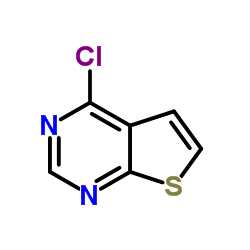
14080-59-2 |
| 文献:Katholieke Universiteit Leuven, K.U. Leuven RandD; Herman, Jean; Louat, Thierry Patent: US2014/88088 A1, 2014 ; Location in patent: Paragraph 1228-1230 ; |
|
~99% 
14080-59-2 |
| 文献:Warner-Lambert Company Patent: US5654307 A1, 1997 ; US 5654307 A |
|
~97% 
14080-59-2 |
| 文献:KATHOLIEKE UNIVERSITEIT LEUVEN, K.U.LEUVEN RandD; De Jonghe, Steven; Gao, Ling-Jie; Herdewijn, Piet; Herman, Jean; Jang, Miyeon; Leyssen, Pieter; Louat, Thierry; Neyts, Johan; Pannecouque, Christophe; Vanderhoydonck, Bart Patent: US2013/190297 A1, 2013 ; Location in patent: Paragraph 1213; 1214; 1215 ; |
|
~% 
14080-59-2 |
| 文献:Tetrahedron Letters, , vol. 48, # 30 p. 5261 - 5264 |
|
~% 
14080-59-2 |
| 文献:Tetrahedron Letters, , vol. 48, # 30 p. 5261 - 5264 |
| 上游产品 5 | |
|---|---|
| 下游产品 10 | |

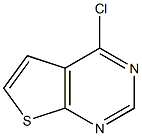
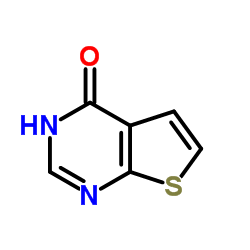

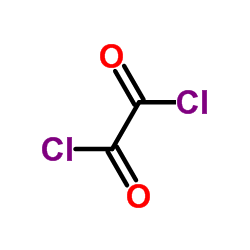
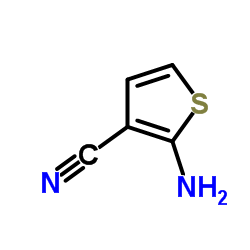
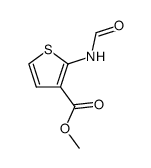
![(噻吩并[2,3-d]嘧啶-4-基硫代)乙酸结构式](/20230522/18740-26-6.png)
![噻吩并[2,3-d]嘧啶结构式](/20230522/272-24-2.png)
![6-bromo-2-butyl-4-chlorothieno[2,3-d]pyrimidine结构式](/20230522/1217309-72-2.png)
![4-氯-6-溴噻吩并[2,3-d]嘧啶结构式](/20230522/56844-12-3.png)
![噻吩并[2,3-d]嘧啶-4-硫醇结构式](/20230522/14080-55-8.png)
![噻吩并[2,3-d]嘧啶-4-胺结构式](/20230522/14080-56-9.png)
![4-甲氧基噻吩并[2,3-d]嘧啶结构式](/20230522/14080-52-5.png)
![4-氯噻吩并[2,3-d]嘧啶-6-羧酸结构式](/20230522/86825-96-9.png)
![6-溴噻吩并[2,3-D]嘧啶结构式](/20230522/60703-80-2.png)
![N,N-dimethylthieno[2,3-d]pyrimidin-4-amine结构式](/20230522/63893-52-7.png)





 浙公网安备 33010802013016号
浙公网安备 33010802013016号